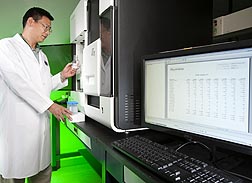Obesity During Pregnancy
Scientists Explore Impacts on Baby's Bone Health
No one knows precisely how Mom’s obesity, during her pregnancy, might affect baby’s chances of developing strong, healthy bones. But ARS-funded studies at the Arkansas Children’s Nutrition Center in Little Rock may provide clues.
Jin-Ran Chen, M.D., a principal investigator in the center’s Skeletal Development Laboratory, has shown that bone development of the unborn young of mother lab rats (dams) fed high-fat rations—to induce obesity—was “significantly impaired,” in contrast to the bones of the fetal young of dams that were given lower fat rations.
Analysis of fetal bone cells from the skull and vertebrae suggests that changes in the functioning of a gene, HoxA10, may help explain this difference in early bone formation. Studies by scientists elsewhere have already established that the gene is important to bone formation and growth. But Chen’s investigation is apparently the first to suggest that obesity, induced by the high-fat regimen, may turn off (downregulate) this gene, thus suppressing robust bone development.
Chen and team found that HoxA10 was downregulated as a result of high levels of DNA methylation, a biochemical process also referred to as “gene methylation.” This hypermethylation “essentially turned off this critical gene,” Chen explains.
But that’s not all. DNA methylation is already known to be what scientists describe as an “epigenetically regulated mechanism,” in which the structure or sequence of a gene is not changed, but the way the gene functions is.
Epigenetic changes in a gene’s function can be permanent, meaning that the impairment in bone development the scientists observed may last throughout life.
If the results seen in the rats hold true for humans, elevated methylation of HoxA10 may increase baby’s risk of developing bone disease, such as osteoporosis, later in life, Chen says.
Right now, an estimated 10 million Americans have osteoporosis, and another 18 million are at risk of developing this degenerative disease. Osteoporosis reduces both the mass (amount) and the density of bone, thus increasing the risk of hip, wrist, and spine fractures.
In followup studies, Chen will track bone health in offspring of obese and “lean” dams to learn more about the consequences of the mothers’ nutrition regimens. “Everything we’ve learned so far,” says Chen, “suggests that it’s critical to start early in making sure a mother’s nutrition benefits her developing child’s bone health.”
Chen and colleagues Tom Badger, Mike Blackburn, Ping Kang, Oxana Lazarenko, Martin Ronis, Kartik Shankar, and Jian Zhang, all with the nutrition center and with the University of Arkansas for Medical Sciences, documented their findings in a peer-reviewed scientific article published in 2012 in the Federation of American Societies for Experimental Biology’s FASEB Journal. The nutrition center is a partnership between ARS, the university, and Arkansas Children’s Hospital, also in Little Rock.—By Marcia Wood, Agricultural Research Service Information Staff.
This research is part of Human Nutrition, an ARS national program (#107) described at www.nps.ars.usda.gov.
Jin-Ran Chen is with the USDA-ARS Arkansas Children’s Nutrition Center, 1120 Marshall St., Little Rock, AR 72202; (501) 364-2707.
"Obesity During Pregnancy: Scientist Explore Impacts on Baby's Bone Health" was published in the February 2014 issue of Agricultural Research magazine.







